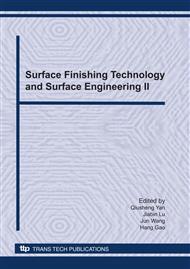p.69
p.73
p.79
p.84
p.90
p.96
p.102
p.107
p.111
Study on Friction Force Distribution on Silicon Wafer Surface in CMP Process
Abstract:
The friction force on wafer surface plays an important role in removing material of wafer surface and the friction force on wafer surface may have a direct influence on non-uniformity of material removal in wafer CMP process. In this paper, models of friction force on wafer surface were built according to the CMP process. It is proved that the model of the friction force on the wafer surface is correct by the silicon wafer CMP Friction experiment. Then the data fitting of friction model has been done with the experimental data. By the friction force model, the within wafer nonuniformity (WIWNU) of friction force distribution on wafer surface has been obtained with different rotational speed of wafer and polishing pad. The research of this paper is helpful to further understanding the material removal mechanism in wafer CMP.
Info:
Periodical:
Pages:
90-95
Citation:
Online since:
October 2010
Authors:
Price:
Сopyright:
© 2010 Trans Tech Publications Ltd. All Rights Reserved
Share:
Citation:


